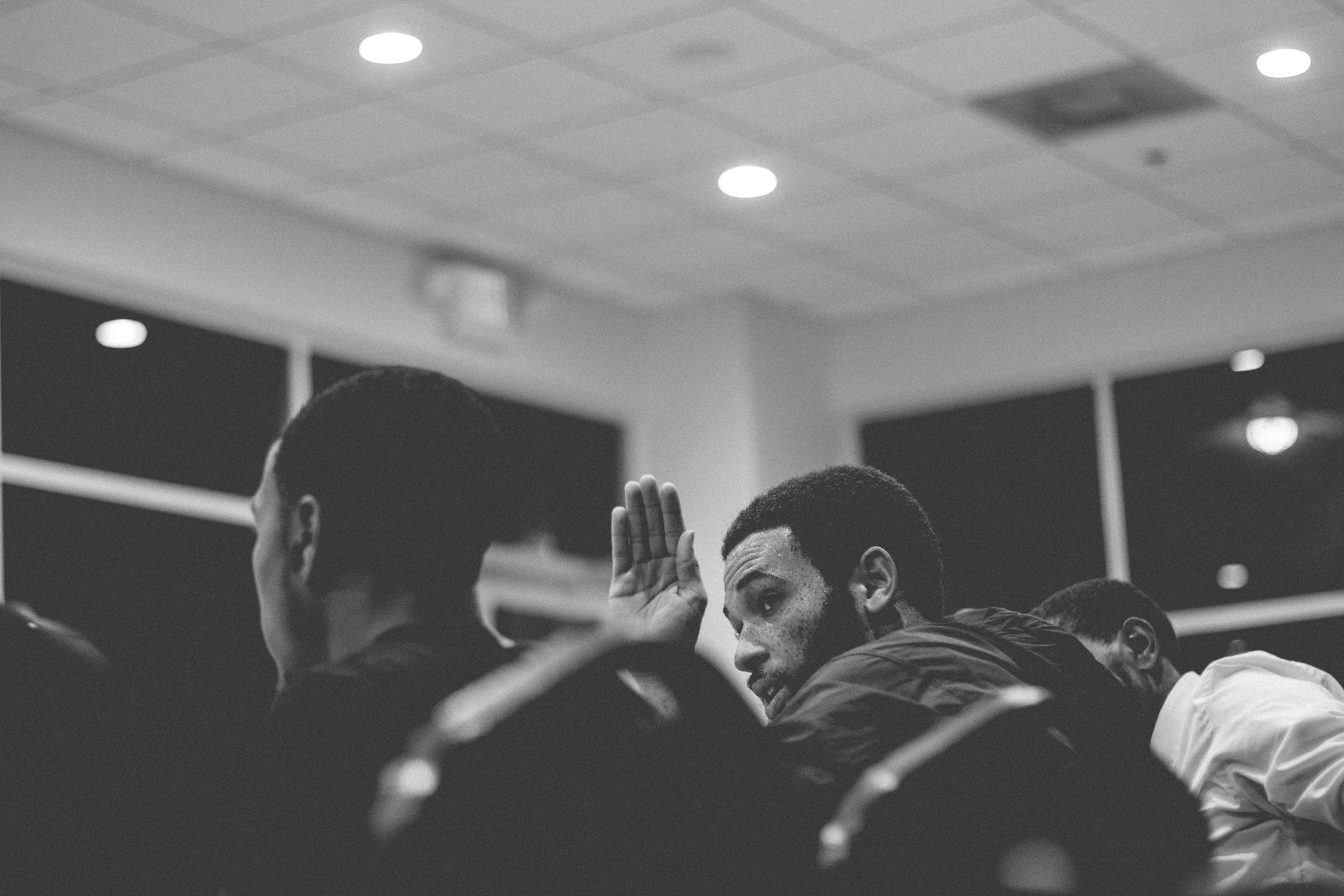Sean Michael Morris
I have a tradition of getting really sick to my stomach before every presentation. Every keynote. Every opening remark at Digital Pedagogy Lab. Every lesson taught in a classroom. Every first video filmed for an online class.
Rolling Stones lead singer Mick Jagger used to eat a special banana before every performance. Sting did yoga.
I make references that age me. And I get sick in my stomach.
Right now, if you were close enough to tell, you’d see that I’m shaking. You might hear my voice quaver. You might get the sense that my eyes are darting back and forth, looking for a friendly face, a smile, eye contact.
It’s uncomfortable for me to speak in front of people. And yet I’ve chosen a life of teaching—teaching students, teaching teachers—and I founded Digital Pedagogy Lab… which means I’ve spoken in front of people on three continents. In vastly different cultures. And every time… I guess it’s like my own special banana before every talk. A good luck charm.
I bring this up because nervousness—shaking, quavering, nauseated nervousness—is exactly what critical pedagogy actually feels like.
Maxine Greene says that “experiences of shock are necessary if the limits or the horizons are to be breached.” It is therefore unwise to sit in our comfort when what we hope to do is unseat, to shrink when what we want is to grow.
So, I stand up and speak. And students attend school.
I first attended a college class when I was 10. It was a Shakespeare course taught by Reg Saner at the University of Colorado-Boulder. My mom had returned to school only a few years before to complete a bachelor’s degree in English, and she decided to take me out of school that day. To go to her school. To see what teachers and discussions and classes were like at the far end of my education.
Here I was accustomed to weekly vocabulary drills, reading books checked out from my elementary school library. I’d never read Shakespeare (though my mom had read me Dickens, Poe, and Frost at that point). But I’d grown up in Boulder, where so many of the roads literally lead to the university. College was a fixture in my life, a geographical one as much as an ideological one. My mother had battled her own fear of speaking to attend her first classes at Metro State University, later transferring to CU Boulder; and there was simply nothing more aspirational in my family than getting a degree.
So, one sunny morning, my mom took me to her Shakespeare class. They were discussing Hamlet. We walked across the campus—a wonder of imported Tuscan architecture, and so green in the springtime before the Colorado heat has baked the landscape. I marveled at the adult children at play on the quad, at the long, silent hallways that felt at once serene and deeply judgmental, the ancient chalkboards and the one particular wooden desk I sat in beside my mom.
She opened her book. She bent her head to take notes. The professor entered. And he spoke.
It was theatre. And I loved every minute of it. Professor Saner’s preoccupation was poetry—writing as much as reading—and so his lecturing voice rolled across the classroom, speaking in longer words than I’d ever heard, and handling the English language so expertly that I was at once envious and inspired.
My mother also adored Dr. Saner, and visited him in office hours often. She purchased his books of poetry. She signed up for every one of his classes that fit her schedule as a mom of three. But when it came time to approach him for a letter of recommendation for her application to CU’s graduate program in English, he told her:
“I’ll write you this one. But I wouldn’t recommend you for the doctorate.”
In “Not Enough Voices,” I write:
“Your students have fought, your students have hidden from bullies, your students have been hungry, they have passed for straight, they have held their tongues, and they have been broken. In many cases, the students you work with have had to subvert a system that sought to oppress them in order to make it to your classroom.”
What happens when they find out, upon entering the classroom, that this oppressive system is alive and well there? What happens when a student who loves to learn is told they are not qualified to to so? And yet, how many of us in this room could, without much effort, identify a student we felt wasn’t built for our field, or for education at all?
Students live in a space of imagination. They have to, if for no other reason than that they are learning. They have come to school at cross purposes with society’s reasons for schooling: for the student, learning—the ache to do it, not necessarily its realization in school—is spurred by a desire to claim their agency, which they can only do through critical thinking and critical imagining; for society, the student will become a bundle of fulfilled outcomes, a set of data which can be applied to a task in the marketplace.
What is particularly interesting about this conflict of interests is that the student, in seeking agency, autonomy, and the ability to see things as if they were otherwise, must front with the expectations of society, which precisely fuel and always also threaten to overturn their agency.
Which is why when they come to school, they are not only learning mathematics, physics, anthropology, English, the world of business, or whichever, they are also slowly learning—through our rubrics, policies, grades, assessments, our delivery of content—not to mention the culture of student shaming and distrust that rolls like the professorial voice does across the room through our halls, across our campuses, into our social media—that they must accept education as it is, to cease questioning it for its greater possibilities.
This is the kind of oppression that Maxine Greene writes about when she says, “The oppression and the domination that I have in mind are the kind that breed ‘false consciousness’ … the kind that subject human beings to technical systems, deprive them of spontaneity, and erode their self-determination, their autonomy.”
It is not, in other words, the oppression we believe our liberal politics or our inclusive approaches, our concern with open educational resources and open pedagogy address. It is the oppression of the letter of recommendation, the oppression of the grade, the oppression of an authority who determines whether or not we are fit to learn, fit to explore, fit to exercise our agency and autonomy.
And yet students have fought, hidden, gone hungry, held their tongues so that they could enjoy the privilege to imagine for themselves something different than the taken for granted, something otherwise.
Let me put it another way: When we turn to learning, we are making a choice to express an interest in things, an action that social philosopher Alfred Schutz might call a move toward wide-awakeness, “a plane of consciousness of highest tension originating in an attitude of full attention to life and its requirements.” This interest in things is what propels learning, it is what propels education. Most of us have arrived here today because we have an interest in things, a desire to become more wide awake.
Henry David Thoreau tells us in Walden that “We must learn to reawaken and keep ourselves awake, not by mechanical aids, but by an infinite expectation of the dawn, which does not forsake us in our soundest sleep.”
Infinite expectation of the dawn. Imagine if that’s what each new semester felt like. Imagine if that’s what a dissertation defense felt like. Or the five paragraph essay. Or your syllabus.
But of course we have built machines and systems designed for slumbering—those “technical systems” that Greene points out deprive us of our spontaneity. She writes that “attentiveness, this interest in things, is the direct opposite of the attitude of bland conventionality and indifference so characteristic of our time.”
We have created best practices “to guard us against the incalculable difference of students.” We have created the learning management system to parse learning into discrete moments and sections, all interrelated through the will and capacity to grade and assess. We have filled the university with processes and committees and an economy of reputation which rewards us for our compliance exactly as it blunts our wits and bores us to tears.
These are the machines we’ve designed for slumbering, for exactly not staying awake. And when we don’t challenge them, when we shrug and say “It is sad, but what can be done. This is what reality is,” then we are surrendering to the conditions we see around us, to indifference—instead of saying “Reality is not inexorably that.”
“The opposite of morality,” Greene writes, “is indifference—a lack of care, an absence of concern. Lacking wide-awakeness…individuals are likely to drift, to act on impulses of expediency.”
And what is more expedient than the rubric, the grade, the standardized assessment, the LMS? I propose that when we notice that our systems and tools are built for efficiency, we choose to recognize not their time-saving features, but the way they encourage indifference, the way they lull us to sleep.
Critical digital pedagogy isn’t this:

It’s not the wonder of a new Canvas LTI. But it’s also not the thrill of taking a tool down a notch.
Critical digital pedagogy is this.

And this.

And this.

The whole point of everything I’m saying is that we have not only a right to imagine education as if it were otherwise, but we have the responsibility to do so. A responsibility as educators to students, to the very systems of education, to the tools we use in class, to the mechanisms we employ to assess, and the approaches we use to include, validate, and keep human students.
But also a responsibility as educators to ourselves. To the very curiosity that has brought us here today, that took us through the humbling of our dissertations, the long nights of little food and much scholarship, the weird bantering arguments of grad school, and the doubt. Always the doubt.
Freire insists that the future is not inexorable. We can intervene. On a small scale, but no less important, we can say that grades are not inexorable, learning objectives are not inexorable, the rubric, textbooks, the lecture, all those component parts of education which have been passed down to us and which we pass down because “This is what reality is”—even the keynote—none of these things are anything more than interpretations of reality. We have the agency to change them, no matter what they are.
Agency is nothing more complicated than our ability to intervene in reality as historical subjects. Which means things can change, can be otherwise.
This is why we’re here today. Or, I think so. To practice agency. To look at what we may have become inured to and to raise our heads and think (with a q) about new possibilities—possibilities made available through critical digital pedagogy, new thinking about design, and remixing pedagogies.
We have to be careful when we talk about remixing pedagogies, though, that we’re daring ourselves to invent something, to push farther forward on the long arc of justice, rather than holding onto that which we have always known and are unwilling to let go of. Things as they are. Things we take for granted. A submergence in the habitual.
But let me back away for just a moment from all of this high-falutin’ language. There’s a constant threat with critical pedagogy that it can become so purely theoretical. But, as I wrote to a friend recently,
“There are times when a critical pedagogy refuses to be merely theoretical. It is a tradition that comes out of a concern for labor, for the agency of those doing labor, and the perspicacity inherent behind that agency. The imagination is not an impractical facility at all, not a dreamer’s tool only, but a precision instrument that delivers a certainty that things can be otherwise.”
And so let’s take a look at one particular innovation that works to address the problem of student agency in education:
Domain of One’s Own, or “Domains” (or, Ms. Domains, if you’re nasty). The Domains project started at the University of Mary Washington as an extension of the digital storytelling course, DS106. According to the Division of Teaching and Learning Technologies web site, Domains allows
“students, faculty, and staff to register their own domain name and associate it with a hosted web space, free of charge while at UMW. With their Domain and corresponding web space, users will have the opportunity and flexibility to design and create a meaningful and vibrant digital identity.”
According to one of its originators, Martha Burtis, there are four goals embedded in Domain of One’s Own:
- Provide students with the tools and technologies to build out a digital space of their own
- Help students appreciate how digital identity is formed
- Provide students with curricular opportunities to use the Web in meaningful ways
- Push students to understand how the technologies that underpin the Web work, and how that impacts their lives
In short, Domains allows students to create a space on the web that they can call their own, upon which they can write their digital identities, and through which they learn about digital technologies and tools, the affordances and limitations of both, and what it means to have a digital fingerprint.
According to Martha, the Domains project rose out of a moment of critical looking, followed shortly on by imaginative thinking.
“We’ve doubled-down on courses and the LMS, we’ve bought into the notion that what technology afforded us for teaching and learning was standardization of experience and pedagogy, and we’ve abandoned the nascent spaces that might have let us continue to explore the Web as a flexible, open, and powerful platform for teaching and learning.
“And we’ve spent so many years going down this path that there are now powerful monetary investments and administrative processes and expectations pounding on our backs, pushing us further and further.
“How do we make it stop?”
Domain of One’s Own rose out of the kind of practice that Greene and Freire both advocate for, the kind of practice which is at the core of critical pedagogy: the recognition of a reality that’s less than desirable, a further recognition that that reality isn’t inexorable, and the determination to intervene.
Domain of One’s Own is as fraught as it is successful. And every step of the way—even now, after six years—working with Domains is anything but simple. It is that nervous, shaking, quavering experiment which is what critical pedagogy is all about. Questions abound: what do we do about assessment? should Domains even be curricular? what do we do with old Domains after students graduate? what sorts of freedoms should be encouraged, what sort of ethics should be maintained? what are the skills we’re teaching with Domains? what skills is the Domains project teaching us?
There are the practical considerations about archiving and storage, assessment and grading, and the place of Domains in the curriculum. And there are the theoretical questions: is a student’s domain really their own? does Domains hark or not hark back to Virginia Woolf’s “A Room of One’s Own”, and her refusal of an unendurable reality, her demand for a space of reflection and self-ownership?
The cool thing is that the problems with Domains are also its joys, for to work with Domains requires a wide-awakeness to the project itself, and to the students and teachers and others who use it, explore it, defy its immediate constrictures. In other words, the very best part of Domains has nothing to do with the web at all; it has to do with how we as humans encounter the questions it raises.
The Domains project should make us nervous. It should leave us a little bit scared. We should look at it every year, every semester, and wonder if it can or should continue. Because this is the work of battling expediency and the machines made for slumbering.
And so perhaps there’s a measure for whether a project is truly critically digitally pedagogical in its intention, execution, and practice: that if we’re not just a little bit scared, if we’re not just a little bit nervous, a little bit pukey, then it’s likely we’re not pushing far enough.
But let me take a quick step back from that, and question even what I’ve just said. This idea of pushing far enough, of turning it up to eleven, can have some pretty rank repercussions.
Back in 2014, I attended the INACOL conference in Palm Springs. At that conference, which was largely for a K12 audience, and was sponsored by the deep pockets of Silicon Valley, I initiated a small, spontaneous unconference with a few participants who all found themselves unhappy with the mostly vendor-centered presentations, the commercializing of elementary education, and the zeal for personalized learning which they recognized as an iteration of B. F. Skinner’s teaching machines.
It’s always great to have a dark side conversation about educational technology. There’s nothing quite like it to keep your fervor going. But it’s hard to maintain a balance of optimism alongside the disgruntle. What’s more, advocates of critical digital pedagogy can become a feisty bunch. And this little unconference was no exception. Amid the delight and haranguing, out popped the question:
“But how do we drag our colleagues into the digital? How do we bring them into the 21st century?”
Those of us who have spent the last many years hashtagging our insights and relationships do have a desire to bring others into the fold. And part of that impulse is generous: we want for them to see what we see, to experience what we experience. This is a reason for teaching, it is a reason for wide-awakeness, for pedagogies of hospitality, openness, agency, freedom, kindness.
As well, in critical pedagogy, there is an impulse toward change. As I said earlier, we have not only a right to imagine education as if it were otherwise, but we have the responsibility to do so. If that’s true, do we also have a responsibility to drag others along with us?
My answer at the time was “no”. If one of our colleagues already finds the fax machine overwhelming, then introducing WordPress will not only not be productive, it will likely shear in half what relationship we have with that person. For me, what is most important to the practice of a critical digital pedagogy is… well, this.

Critical pedagogy, and its digital counterpart, are practices obsessed first and foremost with liberation, with freedom, and with agency. And to that end, the very best thing we can do is to support those whose interest draws them to this work, and thus spread the work where it will grow most rapidly. The caution here is that when we become insistent that our colleagues follow along our desire lines—and not their own—we run the risk of oppressing them.
We can be the judge of our own work, but we cannot hold sway over the work of others. We cannot deny them access, we cannot make them dependent on our blessing.
At the beginning of this year, I wrote:
“Critical pedagogy, digital pedagogy, #digped—none of these is our community. Increasingly, I recognize that there is no “us” when “us” means “our.” Should we find ourselves saying that someone is a good fit for our community, we are also saying that someone else is not. Some have seen me as a poor fit for their communities; and so how could I turn around and guard the gate in that fashion? Generosity of spirit, generosity of dialogue, generosity of justice, cannot be exclusive.”
Here at the end, I want to return to my mother. Because she is not here, though I invited her. She is not here because she would not feel like she belonged. And she’s not here because Reg Saner wouldn’t recommend her to the highest degree.
My mother is in her 70s. She’s on a fixed income. And she teaches as an adjunct for the Colorado Community Colleges Online. Every semester for the last ten years, she has worried about whether she would get enough courses to make ends meet.
But none of this keeps her from taking risks for students. None of this keeps her from caring for her students. She shared with me some encouragement she offered one of her students recently, one who felt they had failed to do well, failed to meet the expectations of the Developmental English course my mom teaches. She wrote:
“I have pretty vivid memories of when I started college. I was sooooo anxious. Even when I made it through the first semester, I kept thinking, ‘How am I going to be prepared for 200-level, 300-level, and oh goodness, 400-level classes?’
“Well, the odd thing is that I seemed to somehow absorb knowledge from one semester to another. It was not conscious; but somewhat mysteriously, it happened…And, honestly, when I grade, I sense this. Final drafts may still be a bit rough, but there is learning happening even when the thoughts may not seem to come together as hoped.
“So, I guess what I’m trying to say, is: Trust in the learning process.”
A lifetime later, my mom is encouraging students to believe in themselves, to hold fast to their agency, and to be incredibly patient with what Freire might call the “long march” of critical pedagogy. The progressive task “to encourage and make possible, in the most diverse circumstances, the ability to intervene in the world—never its opposite, the crossing of arms before challenges.”
With that, I encourage you all to step into our work today with open arms, with insistence and care, with imagination, and with the idea that things can be otherwise.
